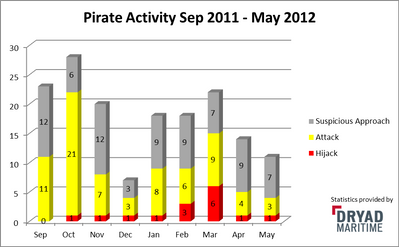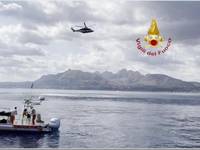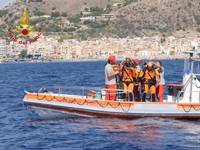Dryad Maritime Cautions Against Pirate Attack
Leading Maritime Intelligence Agency Cautions Against Complacency Following First Attack of the Piracy Season.
Pirate operatives have awoken from their hibernation to venture forth from safe havens and launch long-range mothership-enabled pirate operations with the first confirmed attack in the Arabian Sea on Monday this week.
Following three months of very limited deployments constrained to the Southern Red Sea, Gulf of Aden and sheltered areas along the Omani coast, Dryad Maritime predicted that, despite industry optimism of 2012, the end of the South West monsoon season will see the resumption of pirate attacks. The first attack of the pirate season came on Monday when an Omani dhow was attacked near the port of Salalah.
“Somali pirates are not out of business, even if times are hard when compared to the success of earlier years. The pirate business has suffered a few setbacks, but the threat remains a very real one; the capability is intact and the motivation of those engaged is unlikely to have been diminished to the point of defeat. The message is clear - complacency is the greatest threat and constant vigilance, the greatest weapon in the fight against Somali pirates”.
Ian Millen, Director of Intelligence, Dryad Maritime Dryad Maritime’s combination of monitoring and regular observation of environmental conditions has confirmed that, over recent weeks, wind speeds and wave heights across the Indian Ocean and Arabian Sea have decreased heralding the approach of the inter-monsoonal period. This will create the optimum conditions for pirates to test the water further afield, no longer constrained by adverse weather conditions. However, various international maritime bodies have heralded the end of this year’s monsoon season as ‘pivotal’ going so far as to champion cautious optimism. Indeed recent statistics would support this approach.
The relative calm of recent weeks has been a reflection of the suppressive operations conducted by naval forces in waters normally featuring pirate activity (Gulf of Aden and Southern Red Sea) in previous South West monsoon periods. Only a few months ago the US Navy issued a report which showed acts of piracy in the treacherous waters around the Horn of Africa had fallen sharply. This was supported by a similar paper issued by the International Maritime Bureau (IMB). The numbers are astounding and encouraging - only 46 pirate attacks occurred in the area in 2012 compared with 222 in 2011 and 239 in 2010. Only nine of the piracy attempts this year have been successful, a significant decrease set against 34 successful attacks in 2011 and 68 in 2010 (See Dryad’s Pirate activity graph 2010-11).
“In the face of such figures, we could be forgiven for thinking that it is ‘game over’ for Somali pirates, beaten into submission by coalition maritime forces and frustrated by the layered defence of predictive intelligence, armed guards and effective physical protection. To do so, however, would be a big mistake because so little has changed when viewed through the eyes of the maritime criminals in question”.
Ian Millen, Director of Intelligence, Dryad Maritime
This sea-change is largely attributed to both aggressive patrolling by international forces and increased vigilance by the commercial shipping industry. Commercial vessels are increasingly carrying armed security teams and no vessel with such a team on board has yet been hijacked.
Even Superyachts with their superior speed and maneuverability carry armed guards when transiting through the high risk Gulf of Aden area. Similarly, 2012 has seen a number of well reported high profile counter-piracy raids conducted by US and European forces. Some experts believe this is acting as a deterrent to potential hostagetakers. March saw the release of Judith Tebbutt who had been held since September 2011; July, Deborah Calitz and Bruno Pelizzari held for seventeen months and in August, the crew of the MV Albedo who had been held since November 2010. Dryad concur with security commentators that for the first time in many years there are no cruising sailors known to be held captive by pirates. The most striking fact is that there have been no successful pirate attacks on large merchant vessels since May and none attempted since the end of June. Although this is normal and expected in open ocean areas during the monsoon season, it is the longest gap in pirate attacks in the last five years in the Horn of Africa.
But this optimism must be tempered, piracy remains rife in the waters around Somalia meaning that the most popular and natural route for recreational sailors is still firmly off limits and all cruising sailors are still advised in the strongest possible terms to avoid the North Western Indian Ocean. Based on the changing trends a transiting yacht may appear a far more attractive target (despite meagre pickings) than a commercial vessel. Despite the interventions carried out by international naval forces which act as a preventive measure to contain pirate motherships and skiffs in harbour; with well over 1000 miles of Somali coastline to launch from, Dryad predicts that pirates will manage to get to sea and evade military patrols in the area.
Similarly, following the end of the South West monsoon, Dryad advise that the sheer vastness of the Arabian Sea and Indian Ocean will open up for pirate business. It is extremely difficult for international naval forces to comprehensively patrol such a sizeable threat area and responding to incidents in such open ocean areas is by no means instantaneous. Although there are plenty of statistics and reports to show months of inaction, Dryad Maritime have issued guidance to caution against complacency - the biggest threat to vessels at sea. Somali pirates only have to get lucky once to carry out the next successful hijacking.
Dryad’s Recommendations
Dryad’s advice to mariners focuses on continuous vigilance and strict compliance with internationally recognised measures for reducing risk. The first step to reducing risk ina high threat area is comprehensive planning taking into account the historical and current pirate threat, alongside prevailing weather conditions. Vessels should also register with the appropriate authorities such as UKMTO and MSC HoA to let the right people know where they are and effect timely assistance or enable proactive naval interventions should they observe or fall foul of pirate action. The risk of pirate attack and hijack can further be reduced through the provision of intelligence, constant crew vigilance, dynamic re-routing and taking appropriate measures to harden and protect the vessel.





